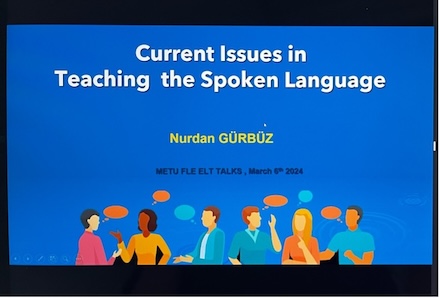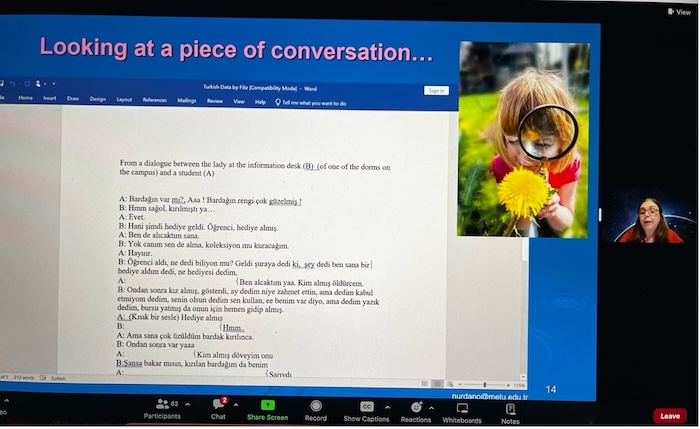 Review: Current Issues in Teaching the Spoken Language by Serpil Öz
Review: Current Issues in Teaching the Spoken Language by Serpil Öz
Assoc. Prof. Dr. Nurdan Gürbüz METU FLE ELT Talks, March 6th, 2024
On March 6th, Assoc. Prof. Dr. Nurdan Gürbüz gave a talk on the evolving challenges of spoken language. Focusing on shifts from accent to message, she explored the impact of global movement, intercultural communication, and technology on English as a global language. The discussion questioned traditional native speaker norms in a world where non-native speakers outnumber natives. Nurdan Gürbüz emphasized the rising importance of "intelligibility" and provided practical insights for educators, spanning spoken grammar, willingness to communicate, speaking anxiety, and learner cognition. The talk included practical strategies for building speaking confidence through engaging content, diverse assessments, and effective feedback techniques.
She started her talk by talking about speaking as a skill in the 21st century. She mentioned that speaking is and has been a real challenge. Different from the past, some things have changed. People started to move quickly from one place to other and impacted the way people use English as a global language. For example, today when speaking the focus is not the accent but the message to be transferred – and it is now more about how smart people use the language. There are some other things which have changed along with the 21st century; intercultural communication, the concept of World English (WE), technology, and flexibility are some of the aspects which have affected language.
Does that mean “bye to native speaker norms”? In today’s world, the number of non-native speakers outnumbered the native ones. To exemplify this, she mentioned an example EFL exchange where we could observe the impact of at least three different languages (a Turkish talking to an Italian in the UK for business purposes) and cultures in each EFL exchange. As Graddol (1997) mentioned, “native speakers may feel the language ‘belongs’ to them, but it will be those speak English as a second or foreign language who will determine its world” (p.10).
With the changes of the century, the pace of life and communication, the expectations from the language, or the way people perceive what language means have also changed. Thus, the term “intelligibility” started to play a more significant role. The term simply refers to the degree to which a particular language or speech is clear, understandable, and comprehensible to speakers of that language or to speakers of related languages. It assesses how easily someone can make sense of spoken or written communication in each language. In linguistic studies, intelligibility is often considered in the context of “mutual intelligibility”, which refers to the ability of speakers of different but related languages to understand each other without prior exposure such as pronunciation, vocabulary, or grammar. However, she mentioned that people sometimes use some of their culture-specific conversational strategies and behaviors that sometimes may cause conversational breakdowns saying “ya, tamam, şey, işte etc.” from Turkish language, for instance. She then continued by saying that if, for instance, everyone speaks any language (English in our case) in their own way – it may cause chaos in conversations.
To address this, she suggested that we, as teachers, could be careful and aware of “intelligibility” of language in our teaching practices. To do this, she actively uses an analysis of natures of spoken language in students' mother tongue first. She mentioned that before teachers expect their students to join the discussion (whatever the discussion is), we should give them a chance to observe a conversation in their mother tongue to observe the dynamics of their original language, to also observe the chaos, to observe the cultural aspects, how much repetitions they include and how natural it could be, and how they are very contextually bound. Therefore, it is very valuable for students to observe the dynamics of their own language. Please refer to the sample she used in her classes:

This would give students a chance to see the issues even in their daily language in English and EAP is another aspect to consider in this sense.
She highlighted another aspect of speaking to be considered while teaching it which is “spoken grammar”. It refers to the set of rules and structures that govern how language is used in spoken communication. It includes the patterns and features specific to oral language, distinguishing it from written grammar. While there is significant overlap between spoken and written grammar, spoken language often exhibits certain characteristics that make it more informal, flexible, and dynamic which could be counted as colloquialism and informality (how language works in different settings), ellipsis (omitting certain words that can be easily inferred from the context), incomplete sentences, discourse markers such as “uh, um, you know, like”, intonation and stress, and interactional features such as “turn-taking or back-channeling”. Michael McCarthy has contributed a lot on spoken grammar aspect. Please refer to some of the resources she suggested to refer to this aspect(1).
Another aspect to consider while teaching speaking is “Willingness to communicate(2)”, which encompasses learner motivation and individual differences. In line with this, speaking anxiety should be considered while teaching speaking as most of the students perceive speaking skill as an anxiety provoking factor. According to Öztürk and Gürbüz (2014), “pronunciation, immediate questions, fear of making mistakes and negative evaluation are the major causes of EFL speaking anxiety”. “Learner cognition” which includes learner beliefs and attitudes is whole other dimension to consider while teaching speaking.
To address the aforementioned aspects and in order to build speaking confidence, she suggests dealing with it by working on the course content, assessment through variety of tasks, giving effective feedback. Before the course starts, she suggests working on the course content including some film talks, website search based on students’ interests, songs, short films, and TED talks etc. – these kinds of personal tasks which they could add their personal touch and relate to their life could help them build more confidence in speaking. While doing such kind of tasks, they do not only use the language, but they have a nice context for the discussion. After her course was over, she collected feedback considering the ways to reduce speaking anxiety and its relationship regarding the application of these and she collected very positive feedback about this part.
Assessment is another aspect to consider while teaching speaking. First and foremost, she suggests benefiting from offering various speaking tasks (not only ‘discussions’ throughout the course or the exams, for example) so that students can find their way to find their own way to express themselves. She added that while offering various speaking tasks, detailed rubric is necessary for each. While assessing speaking (formally or informally) being flexible is also very valuable for student development and learning. In addition, while assessing speaking, if there is time, it is precious for teachers to give their students a second chance and giving them a chance to try again – this will be more rewarding for the teacher as well.
Finally, she mentioned the feedback aspect of speaking skills. Considering the number of students in each class, it may not be very convenient for teachers to give individual feedback all the time. She highlighted the importance of descriptive and constructive feedback and one of which was self-reflection by asking questions such as “what makes it effective?”, “how was it?”, “what do you think?”. However, sometimes students can be so cruel to themselves and, surprisingly, they can also be very objective before their teachers say a single word about their performance. She added the feedback technique called “feedback sandwich”:

References:
Spoken Grammar (1)
Cambridge University Press ELT. (2023, October 26). [Spoken Grammar: why is it important? Michael McCarthy]. YouTube. https://www.youtube.com/watch?v=gDYy3qucwFY
Crystal, D. (Year of publication). Let’s Talk: How English Conversation Works [Google Books]. Retrieved from https://books.google.com.tr/books?id=4qWKyAEACAAJ&printsec=frontcover&source=gbs_atb&redir_esc=y#v=onepage&q&f=false
Luke's English Podcast. (2020, Aug 1). [676. David Crystal Interview: Let's Talk - How English Conversation Works] [YouTube video]. https://www.youtube.com/watch?v=-YZiWvdQ76Q
Michael McCarthy, Ronald Carter, Spoken grammar: what is it and how can we teach it?, ELT Journal, Volume 49, Issue 3, July 1995, Pages 207–218, https://doi.org/10.1093/elt/49.3.207
Willingness to Communicate (2)
Dörnyei, Z., Henry, A., & Muir, C. (2015). Motivational Currents in Language Learning: Frameworks for Focused Interventions (1st ed.). Routledge. https://doi.org/10.4324/9781315772714
Öztürk, G., & Gürbüz, N. (2014). Speaking anxiety among Turkish EFL learners: The case at a state university. Journal of Language and Linguistic Studies, 10(1), 1-17.
